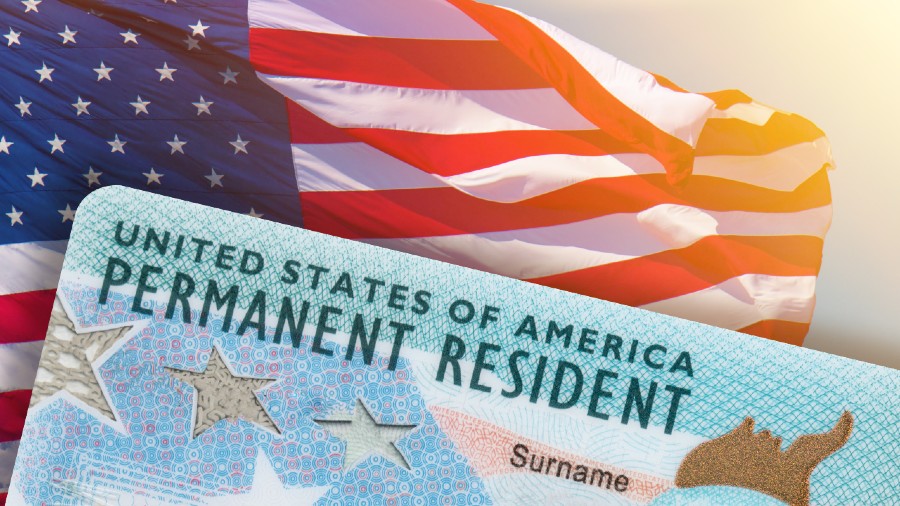Permanent Residency in the USA (Green Card): How To Get One
You can obtain a green card (permanent residency) in a number of ways by working or accepting a job offer. These situations typically include a number of different steps and are among the most challenging in terms of residency.
Step 1: The U.S. employer must submit a labor certification application to the U.S. Department of Labor for the majority of employment-based residencies. These days, PERM is the term used to describe this. Nevertheless, numerous job categories do not require that certification.
Step 2: Following USCIS's approval, the applicant for residency must file a petition for an immigrant visa.
Step 3: The State Department must assign an immigrant visa number to the applicant; this grants the applicant an immigrant visa.
Step 4: The candidate may petition to have their status changed to permanent residency if they are already in the country and are in a legal situation. They will be notified to complete the procedure through a U.S. consulate if they are outside of the country.

WHO CAN GET THE GREEN CARD
Employment-based residency fall into three types under US law (known as preferences)
First Choice Is Given To...
people with exceptional talent in the arts, sciences, business, or athletics. You need proof of consistent national or international acclaim and recognition in your area of expertise in order to be eligible for this. As long as you're entering to continue working in the field in which you have exceptional talent, you don't need a job offer if you qualify.
international acclaim for outstanding academics and researchers with at least three years' experience in either teaching or research. For this category, you don't need a labor certification either, but you do require a work offer.
Certain executives and managers who have worked for the foreign affiliate, parent, subsidiary, or branch of the American company for at least one of the three years prior. You must be moving here in order to fill a managerial or executive position. For this category, you don't need a labor certification, but you do require a work offer.
Second Choice Is Given To...
People with advanced degrees in their fields or those with exceptional talent in the humanities, sciences, or business. You must have a labor certification, a Schedule A classification, or be able to prove that you are qualified for one of the shortage occupations listed in the Labor Market Information Pilot Program in order to fall under this category. A job offer is also necessary for this group. If the exemption will serve the interests of the country, you may ask for a waiver of the job offer and labor certification requirements.
Professionals with advanced degrees are those who hold a bachelor's degree or higher and have at least five years of progressive work experience in their field.
One who holds a degree in the arts, sciences, or business is considered to have remarkable talent.
With Third Preference:
Professionals with bachelor's degrees, specialized workers, and other employees A labor certification, Schedule A classification, or proof that they meet the requirements for one of the shortage occupations in the Labor Market Information Pilot Program are required for this.
People who can do a job that requires at least two years of training or experience are considered skilled workers.
WHAT DOES A GREEN CARD GIVE YOU?
1. It grants you the right to reside permanently in the United States. assuming you don't go against your residence agreement.
2. It grants you lifetime employment authorization in the United States. No longer necessary to get job authorization documents (work permits).
3. It enables you to submit an application for citizenship in three to five years.
4. It grants you permission to enter and exit the United States. However, avoid leaving for longer than six months at a time without first seeing a lawyer.
5. It enables you to apply for a green card on behalf of your spouse and any minor children who are not married.
It enables you to submit an application for specific federal means-tested benefits. This covers initiatives like Section 8 housing, Medicare, Medicaid, SSI, TANF, and TANF. These benefits are nevertheless subject to requirements that US citizens are exempt from. The "look back" period of five years is the most typical of these. Before being qualified to apply for benefits, the majority of permanent residents must maintain their residency status for five years.
WHAT DEFINES A GREEN CARD FROM A RESIDENT CARD AND AN I-551?
Simply put, there is no distinction between an I-551, a Green Card, or a Lawful Permanent Residency Card.
The card's official form number is I-551.
The title of that document is officially and legally known as a Lawful Permanent Residency Card.
The Residency Card is sometimes known as a "Green Card." Although it has been in widespread use for many years, the card has only recently started to be printed with a true green color.

WHAT IS THE DIFFERENCE BETWEEN A RESIDENT CARD AND A WORK PERMIT?
An employment authorization card (work permit) and a legal permanent resident card (green card) are two entirely distinct things.
You can only work in the United States with an Employment Authorization Card for the duration specified on the card (the issuance date to the expiration date). You cannot enter the country or remain there indefinitely with it. All of these rights and more are included with a Green Card.
DIFFERENCE BETWEEN A GREEN CARD AND A VISA
A legal permanent resident of the US is one who holds a green card. It gives you all of the rights and benefits that come with being an American citizen, with the exception of those that are only available to people who may cast ballots (such as running for office). When a person has to travel abroad temporarily, a consulate or embassy will issue them with a visa. The two visa categories that are frequently mentioned are tourist and student visas, however there are numerous additional visa categories available for a variety of purposes.
Your legal status as a permanent resident in the US can be verified by a green card. Many of the rights and privileges that come with being an American citizen are extended to you, with the exception of those that are only available to citizens (such as voting or running for office). When a person has to travel abroad temporarily, a consulate or embassy will issue them with a visa. The two main categories of visas are. visas for immigrants and non-immigrants.
Tourist, student, and some temporary employment visas are typical examples of nonimmigrant visas. There are various types of immigrant visas since it depends on why you want to immigrate (such as family-based or employment-based).
A green card is often sent in the mail shortly after an individual is examined and granted entry into the country using an immigrant visa.
Nonimmigrant visa holders are only permitted to enter the country briefly after being examined and approved entry.